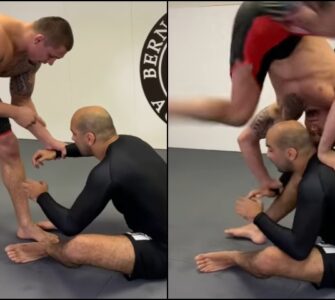The Butterfly Guard is such a versatile position when you’re on the offense; it offers a very wide range of transitions, set ups and even direct submission attacks. That is why, if you are on the opposing end and in someone’s Butterfly Guard, you ought to always have a way out… You should always have at least one escape at your disposal, one that you have confidence in!
Well, Travis Stevens – an Olympic Silver Medalist in Judo and a Black Belt in BJJ under John Danaher – has a Butterfly Guard Pass that is ridiculously simple. No, seriously; it’s so simple and effective that it will become the only one you’ll be doing, both in Gi and No Gi.
FIRST OF ALL, HAND PLACEMENT
First of all, you need to take advantage of the hand fighting. Travis shows that, as you are in your opponent’s Butterfly Guard, you’ll be doing the „standard“ hand fighting with them. However, you’re not doing it for the hand fighting’s sake alone; you are doing this in order to catch an opportunity when your opponent opens their arms out. In other terms, you’re waiting for them to elevate their elbows enough so that you have a clear sight and way towards their hips.
Once they open their arms out, you need to move in with your guard pass setup. Travis shows that you need to shoot one hand towards their hip; basically „knifing“ your way to it. Make sure, as Travis emphasizes, to keep the elbow of that arm on the inside of your opponent’s thigh. Don’t keep it on the top of their leg! You need to keep the tension running through that arm; and the way to do it is by keeping it on the inside and by dropping your weight.
Your other hand, Travis demonstrates, goes to their other leg and cups it right above the knee.
Travis emphasizes that it is exactly because of these hand placements that this pass is great for both Gi and No Gi: „If you do both sports, this will be the only pass you’ll need.“
USE YOUR HEAD AND PASS THEIR BUTTERFLY GUARD
Now is the time to initiate your Butterfly Guard pass. To do that, you first need to hit your head into your opponent’s chest, around the sternum area. When you do this, however, Travis says that you need to make sure to use your forehead; targeting their chest with the area where your hairline is. Don’t do this with the top of your head, as your opponent will be able to push your head down and set up a Guillotine. So, make sure that you use your forehead, and you will stay out of this danger for the most part.
As you hit them with your head, you will knock them off balance and their body will start falling towards the floor. This is the point when you need to get your timing right; you need to start passing when their weight shifts to their tailbone! Don’t wait for them to fall to their back, but seek your opportunity when you’ve just tilted them backwards – this is when your previously established hand placements will come into play.
So, as they are getting tilted back, Travis demonstrates that you need to kick back with your leg (one that is on the same side as the hand you’ve placed on your opponent’s hip) and spin them by pushing them to the side, using the hand you’re cupping their leg with.
From there, establish Side Control.
Watch Travis Stevens demonstrate this simple Butterfly Guard pass below:

















